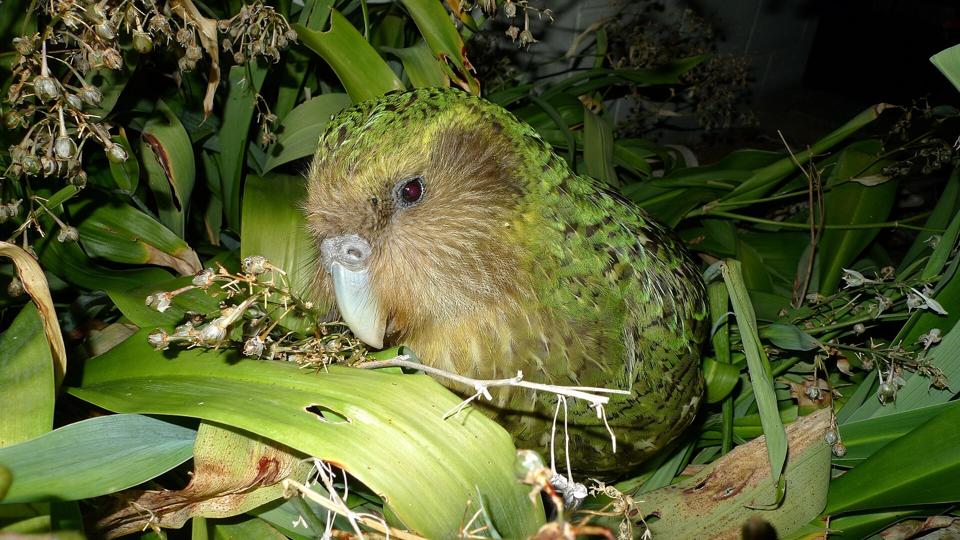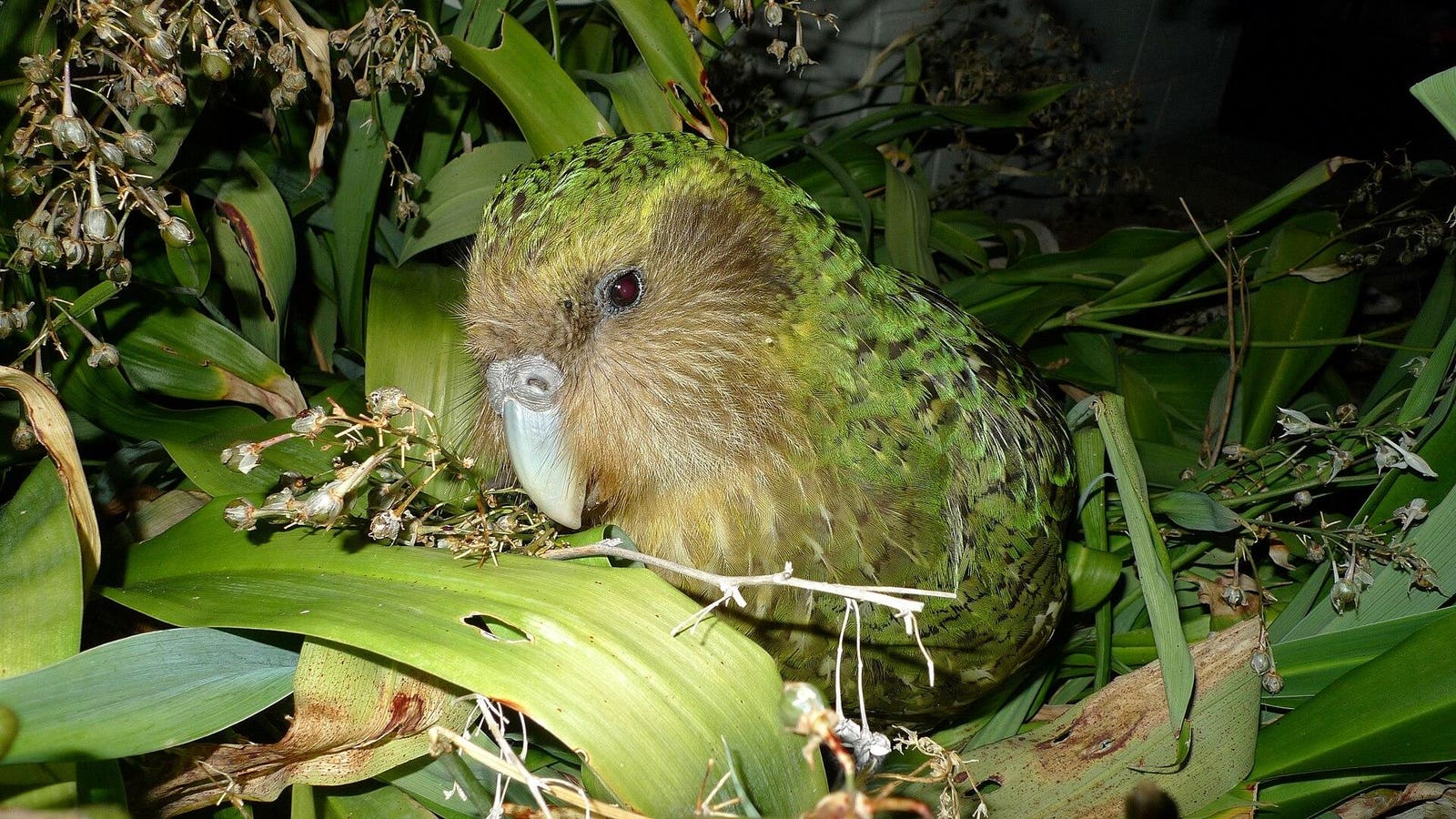So far, so good: Aotearoa New Zealand’s critically endangered kākāpō parrots are not showing signs of antibiotic resistant bacteria – yet.

Celebrity kākāpō, Sirocco, on Maud Island in 2012. (Credit: Department of Conservation / CC BY 2.0)
Aotearoa New Zealand Department of Conservation via a Creative Commons license
With fewer than 250 individual birds remaining in the wild, saving the critically endangered kākāpō, or night parrot, Strigops habroptilus, is one of Aotearoa New Zealand’s major conservation efforts. These giant, flightless, emerald green parrots with a distinctive owl-like face are threatened by predators, invasive species, human hunting and exploitation – and even by a dreaded illness known as “crusty bum” disease. Also known as exudative cloacitis, crusty bum is a debilitating disease that causes inflammation of the lower digestive and reproductive tracts. Exudative cloacitis can cause sterility or even death.
The occurrence of crusty bum disease has been increasing over the last four years across a wide geographic area. Crusty bum disease has been present in the kākāpō population for around 20 years, but its cause remains a mystery. It is typically treated with fluids, pain relievers, and antibiotics. However, the use of antibiotics to treat illnesses comes with the growing risk of developing antibiotic resistant superbugs as well as permanent changes to the bird’s gut microbiome. But so far, the situation for kākāpōs looks okay. A recently published study identifying expressed bacterial genes associated with antibiotic resistance finds that kākāpōs have so far managed to avoid these problems.
“Kākāpō are critically endangered and a taonga (treasured) species of Aotearoa New Zealand,” said the study’s lead author, Natalie Ayriss, a PhD student at the University of Auckland, where she is studying the kākāpō’s microbiome as part of her dissertation.
“Efforts have been somewhat hampered by the emergence of diseases such as aspergillosis and cloacitis, the latter of which we have still found no causative agent for,” Ms Ayriss told me in email. “Kākāpō may spend several weeks undergoing treatment when sick, and often receive antibiotic treatment during this time as part of a holistic approach.”
Endemic to Aotearoa New Zealand, kākāpō are amongst the world’s rarest bird species with a current population of roughly 243 individuals, as of September 2024 – up from a population low of just 51 individuals in 1995. Because the kākāpō population is extremely small and inbred, it is highly vulnerable to the emergence of random pathogens and disease outbreaks as well as the development of antibiotic resistant superbugs, similar to those found in other animals, including humans.
This was the main question that Ms Ayriss and collaborators investigated.
“It was important for us to gain a general understanding of any expression of antibiotic resistance by kākāpō microbes as this may hamper future treatment,” Ms Ayriss explained in email.
To identify microbiome differences amongst kākāpōs of different ages, sexes, geographic locations and antibiotic histories, Ms Ayriss and collaborators sampled 14 adult kākāpō living on two predator-free island refuges and tested for signs of antibiotic resistance by sequencing and analyzing the “antibiotic resistome”: the collection of all antibiotic resistance genes within a microbial community, including those from both pathogenic and non-pathogenic bacteria.
Six of the sampled kākāpōs had historically been treated with antibiotics and eight had not.
Ms Ayriss and collaborators also analysed a time-series dataset collected from a single male kākāpō, Joe, over the course of his successful antibiotic treatment for a case of exudative cloacitis. A total of five samples were collected from Joe; the first sample was collected before antibiotic treatment commenced, then four more samples were collected at 1, 2, 8, and 10 days into his treatment – a treatment that used three different antibiotics concurrently.
In their study, Ms Ayriss and collaborators identified significant microbial differences between chicks and adult kākāpō in the expression of bacterial antibiotic resistance genes.
“As part of on-going work in this area we have managed to isolate E. coli bacteria from fresh kākāpō fecal samples,” Ms Ayriss told me in email. “For many kākāpō, E. coli is the dominant species in the gut and for some individuals it makes up nearly 100% of the community. I am therefore also working to unravel the strain-level diversity of this E. coli.”
According to this study’s findings, kākāpō appear to be lucky when it comes to the absence of antibiotic resistant bacteria in their gut microbiomes. That said, there’s still the risk that microbes in kākāpō could develop antibiotic resistance as the result of frequent future antibiotic treatments or via transmission from other birds or even humans, so antibiotic treatments must be used cautiously.
“We have been testing these isolates for antibiotic resistance and so far we have not detected any resistance,” Ms Ayriss told me in email. “It is still important to point out that we have only obtained isolates for a small number of the population so far, and continued monitoring is important – the continued use of antibiotics is necessary and while they appear to remain effective for now, caution will still be exercised.”
Further, the case study of antibiotic treatment in Joe, the single male kākāpō, revealed a lack of antibiotic resistance gene expression towards the end of his treatment, indicating the continued efficacy of antibiotic treatment in this particular individual.
Once widespread throughout many parts of Aotearoa New Zealand, even into the 1980s, kākāpō were hunted to near extinction. These large flightless parrots can weigh as much as 8.8 pounds, making them the heaviest living parrot species today. They are nocturnal, herbivorous and can live to be 90 years old or more. Thanks to devoted ongoing conservation efforts, kākāpōs are now confined to four predator-free offshore islands and to Maungatautari sanctuary, a protected natural area in Waikato Region on the mainland, south of Auckland, where they have adapted well to changes in the environment and food plants.
Source:
Natalie Ayriss, Annie G. West, Rebecca K. French, Jemma L. Geoghegan, James Chatterton, Andrew Digby, Lydia Uddstrom, Kākāpō Recovery Team and Michael W. Taylor (2025). Influence of developmental stage on the antibiotic resistome and virome of the critically endangered kākāpō (Strigops habroptilus), Frontiers in Microbiology 16:1654781 | doi:10.3389/fmicb.2025.1654781
© Copyright by GrrlScientist | hosted by Forbes | LinkTr.ee
Socials: Bluesky | CounterSocial | LinkedIn | Mastodon Science | Spoutible | SubStack | Threads | Twitter

